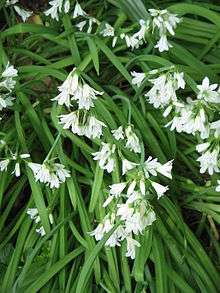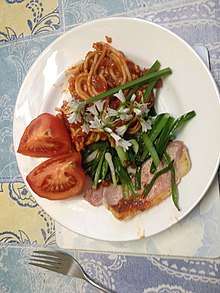Allium triquetrum
Allium triquetrum is a bulbous flowering plant in the genus Allium (onions and garlic) native to the Mediterranean basin. It is known in English as three-cornered leek, and in Australia and New Zealand as onion weed.[4][5] Both the English name and the specific epithet triquetrum refer to the three-cornered shape of the flower stalks.[6]
| Three-cornered leek | |
|---|---|
 | |
| Scientific classification | |
| Kingdom: | Plantae |
| Clade: | Tracheophytes |
| Clade: | Angiosperms |
| Clade: | Monocots |
| Order: | Asparagales |
| Family: | Amaryllidaceae |
| Subfamily: | Allioideae |
| Genus: | Allium |
| Species: | A. triquetrum |
| Binomial name | |
| Allium triquetrum | |
| Synonyms[2][3] | |
Distribution
Allium triquetrum is native to south-western Europe, north-western Africa, Madeira and the Canary Islands, where it grows in meadows, woodland clearings, on river banks and roadside verges from sea level to an elevation of 850 metres (2,790 ft).[7] It has also been introduced to the British Isles, New Zealand, Turkey, Australia, California, Oregon, and South America,[7][8][9] and is a declared noxious weed in some of those places.[10]
Description
Allium triquetrum produces stems 17–60 cm (6 3⁄4–23 1⁄2 in) tall, which are concavely triangular in cross-section. Each stem produces an umbel inflorescence of 4–19 flowers in January–May in the species' native environment.[7] The tepals are 10–18 mm (13⁄32–23⁄32 in) long and white, but with a "strong green line".[11] Each plant has two or three narrow, linear leaves, each up to 15 cm (6 in) long.[7] The leaves have a distinct onion smell when crushed.
Culinary uses

All parts of the plant, from the bulb to the flowers, are edible fresh (for example in pestos)[12] or cooked,[13] with "a subtle flavour like leek or spring onion".[14]
References
- Allan, D.J. (2018). "Allium triquetrum". The IUCN Red List of Threatened Species. IUCN. 208. e.T172157A136261512. doi:10.2305/IUCN.UK.2018-1.RLTS.T172157A136261512.en.
- The Plant List
- Tropicos
- "Angled Onion". Agriculture Victoria. Retrieved 2018-10-29.
- "Allium triquetrum". New Zealand Plant Conservation Network page.
- Hyam, R. & Pankhurst, R.J. (1995), Plants and their names : a concise dictionary, Oxford: Oxford University Press, p. 18, ISBN 978-0-19-866189-4
- C. Aedo. S. Castroviejo; et al. (eds.). "Allium L." (PDF). Flora Iberica. Retrieved April 4, 2012.
- "Allium triquetrum". County-level distribution map from the North American Plant Atlas (NAPA). Biota of North America Program (BONAP). 2014.
- "Onionweed, Allium triquetrum". Wild Picnic, a gallery of useful and edible plants in Wellington and the Wairarapa, New Zealand.
- "Onion weed is taking over". Cire Services Inc. Retrieved 2020-05-25.
- Clive A. Stace (1997). "Allium L. – Onions". New Flora of the British Isles (2nd ed.). Cambridge University Press. pp. 936–941. ISBN 978-0-521-58935-2.
- Shaw, Hank. "Hunter Angler Gardener Cook". Retrieved 27 March 2013.
- Clay, Xanthe. "Recipes made from nature's supermarket". The Telegraph (UK). Retrieved 27 March 2013.
- Pozzi, Doris. "Hello Little Weed – Recipes". Retrieved 27 March 2013.
External links


- Plants for a Future
- Victorian Resources Online
- UC/JEPS: Jepson Manual Interchange
- Allium triquetrum at Calflora

.jpg)